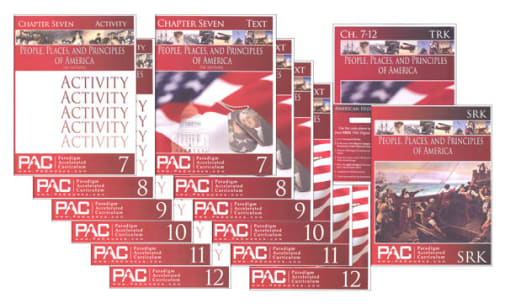People Places & Principles of America Course Kit Chapter 7-12 (Year 2)
Description
This is a comprehensive study of American history from the Civil War to 2012. Content of each chapter is based on the 15 major components of culture: families, agriculture, media, military, government, religion, education, discoveries, industry, communication, leaders, light/energy, art, sports, and transportation. Each lesson incorporates a narrative carefully designed to engage the students emotionally and academically. Theme art, time lines, maps and charts illustrate each lesson to "pull the student's mind" into the text and clarify content. This course has been called "real history" because it ties the fifteen major cultural components to real people, places and principles which distinguish America. It is not revisionist history. The vocabulary level is applicable for students from eighth through twelfth grade. The content is designed to raise students' aspirations for noble and honorable lifestyles of the American Dream. Essential academic elements are aligned with standards normally expected for high school. This course is designed for one high school transcript credit.
The People, Places, and Principles of America is a comprehensive study of American history from pre-Columbus through the election of 2012. Content of each chapter is based on the 15 major components of culture: families, agriculture, media, military, government, religion, education, discoveries, industry, communication, leaders, light/energy, art, music, sports, and transportation. Each lesson incorporates a narrative carefully designed to engage the students emotionally and academically. Theme art, time lines, maps, and charts illustrate each lesson to "pull the student's mind" into the text and clarify content. This course has been called "real history" because it ties the fifteen major cultural components to real people, places and principles which distinguish America. It is not revisionist history.
People Places, and Principles of America I (chapters 1-6) is appropriate for one transcript credit, and People, Places, and Principles of America II (Chapters 7-12) is designed for one transcript credit. Completion of All 12 chapters earns two transcript credits. The vocabulary level is applicable for students from eighth through twelfth grade. The content is designed to raise students' aspirations for noble and honorable lifestyles of the American Dream. Essential academic elements are aligned with standards normally expected for grades eight through high school, either for essential elements or for state exit exams.
Some states require graduating students to know about the Founding Fathers and important national documents; this course covers these topics in chapters 3-6. *(Teachers who omit some sections in order to accommodate state or local school circumstances will need to avoid assigning applicable portions of chapter quizzes and tests.) This is a very popular course, especially for students whose previous enrollment in other schools createdfactual voids in American history. *America's Founding Fathers, Events and Documents is a stand-alone unit study of 15 pertinent topics extrapolated from chapters. 1-6 of the People, Places and Principles of America, and is suitable as an adjunct to other history, government, or civics courses.
| Product Format: | Softcover Book |
|---|---|
| Grades: | 8-12 |
| Brand: | Paradigm Accelerated Curriculum |
| ISBN: | 9781594763434 |
| Length in Inches: | 11.75 |
| Width in Inches: | 9 |
| Height in Inches: | 4.25 |
| Weight in Pounds: | 6.8 |

